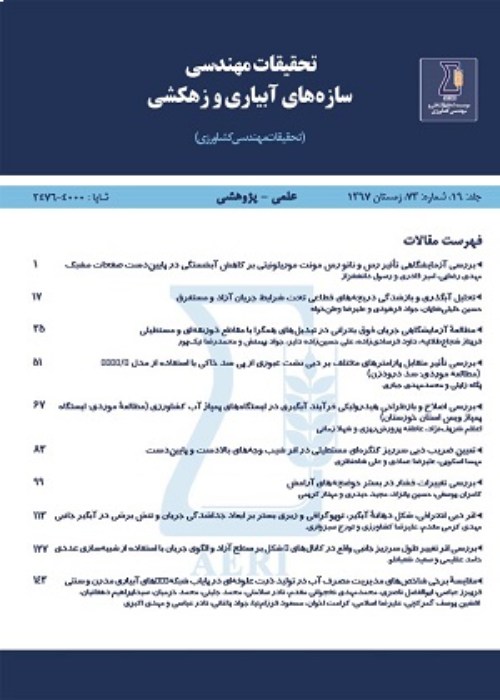The effect of using coated urea on the process of nitrate transfer to different soil depths compared to some types of common fertilizers
In today's agriculture, the use of different chemical and organic fertilizers is inevitable via to adding the amount of production. However, in some cases, application of fertilizers could result to introduce of some pollutants such as nitrates into the environment and water and soil resources. In such a condition, the application of urea coated fertilizers or slow released may cause less pollution. In this research, the amount of nitrate transport in soil profile was investigated due to the application of some common chemical and organic fertilizers in comparison with slow release urea (sulfur coated) fertilizer (SCU). For this purpose, 15 cylindrical columns of soil and water, with a height of 150 cm and a diameter of 10 cm were designed, constructed and used. The columns were filled up to a height of 120 cm with a sandy loam soil. Drainages were installed at different depths of the columns. The amount of applied fertilizers was calculated and applied based on the amount of nitrogen required for the tomato plant. In this research, a statistical factorial with completely randomized design was used to study the factors including: type of fertilizer (no fertilizer as control treatment, urea, ammonium nitrate, coated urea and poultry manure); sampling depth of drainage water (30, 60 , 90 and 120 cm from the soil surface); irrigation rotation (5 times) and sampling intervals in each irrigation (5 times based on specific volumes of drainage water discharge of a complete purvolum of soil) with three replications. The results of the analysis of variance indicated that the effects of the type of applied fertilizer, irrigation rotation and sampling time on the amount of nitrate measured in the effluent samples (nitrate leaching) were statistically significant at the 1% level. But nitrate concentration in the samples prepared from the different depths did not show significant changes. Investigating the mean values of nitrates in drainage water showed that nitrate transfer to soil depth was the highest in ammonium nitrate application (with a mean of 51.67 mg/l) and was the lowest in control treatment (with a mean of 38.39 mg/l). Also, urea fertilizers (with a mean of 48.16 mg/l), poultry (with a mean of 40.70 mg/l) and coated urea (with a mean of 39.88 mg/l) were placed in between them, respectively, and the differences were statistically significant at one percent level. In general, application of coated urea (SCU) fertilizer could have a clear effect on reducing nitrate leaching to soil depth, especially in the condition of this research and in comparison with other types of common fertilizers.In today's agriculture, the use of different chemical and organic fertilizers is inevitable via to adding the amount of production. However, in some cases, application of fertilizers could result to introduce of some pollutants such as nitrates into the environment and water and soil resources. In such a condition, the application of urea coated fertilizers or slow released may cause less pollution. In this research, the amount of nitrate transport in soil profile was investigated due to the application of some common chemical and organic fertilizers in comparison with slow release urea (sulfur coated) fertilizer (SCU). For this purpose, 15 cylindrical columns of soil and water, with a height of 150 cm and a diameter of 10 cm were designed, constructed and used. The columns were filled up to a height of 120 cm with a sandy loam soil. Drainages were installed at different depths of the columns. The amount of applied fertilizers was calculated and applied based on the amount of nitrogen required for the tomato plant. In this research, a statistical factorial with completely randomized design was used to study the factors including: type of fertilizer (no fertilizer as control treatment, urea, ammonium nitrate, coated urea and poultry manure); sampling depth of drainage water (30, 60 , 90 and 120 cm from the soil surface); irrigation rotation (5 times) and sampling intervals in each irrigation (5 times based on specific volumes of drainage water discharge of a complete purvolum of soil) with three replications. The results of the analysis of variance indicated that the effects of the type of applied fertilizer, irrigation rotation and sampling time on the amount of nitrate measured in the effluent samples (nitrate leaching) were statistically significant at the 1% level. But nitrate concentration in the samples prepared from the different depths did not show significant changes. Investigating the mean values of nitrates in drainage water showed that nitrate transfer to soil depth was the highest in ammonium nitrate application (with a mean of 51.67 mg/l) and was the lowest in control treatment (with a mean of 38.39 mg/l). Also, urea fertilizers (with a mean of 48.16 mg/l),
- حق عضویت دریافتی صرف حمایت از نشریات عضو و نگهداری، تکمیل و توسعه مگیران میشود.
- پرداخت حق اشتراک و دانلود مقالات اجازه بازنشر آن در سایر رسانههای چاپی و دیجیتال را به کاربر نمیدهد.


